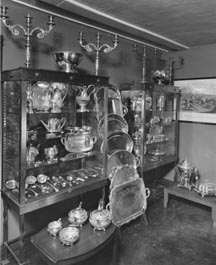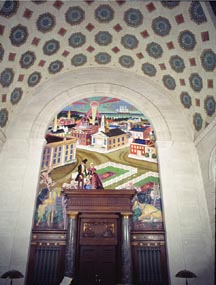 |
 |
 |
 |
 |
 |
 |
1931-1940 |
||||||
1931-1940
1931 -Severance Hall built as the home of the Cleveland Orchestra. -Elsa Vick Shaw painted a series of panels representing the origins of music in the foyer of Severance Hall. She died in 1974. -Donald Gray, landscape architect designed landscaping for first federal housing project in the nation, for Cleveland Cultural Garden and other public properties. He died in 1939. 1932 -Cleveland Print Makers opens a gallery -First Cleveland Curb Market held at University Circle to sell works by hundreds of unemployed artists. Many Cleveland artists are in desperate circumstances over the winter.
-Roosevelt administration creates Public Works of Art Project to provide work relief for artists. -Milliken appointed director of PWAP region nine, encompassing four states. Hundreds of Cleveland artists apply but only 69 can be hired. -PWAP murals for the Cleveland Public -Edward Winter, commissioned by Ferro Company to do series of murals, blue Angelfish in porcelain enamel. In 1944 he also drew a special commission from the U.S. Army to do educational posters. for GIs. He died in 1976. -Potter and Mellen established, originally opened by Horace Potter as The Potter Shop in 1899. 1934 -“The City in 1833,” by William Sommer, 1st of three murals painted for the Cleveland Public Library.
-Federal Art Project of the Works Progress Administration succeeds PWAP in providing work for artists. -Exhibition of works created under the auspices of PWAP and WPA held at the Cleveland Museum of Art. -Traveling exhibition, organized by the Art Museum, of paintings by Cleveland artists circulates to seven venues. -Thelma Frazier, enamelist and sculptor taught at Cleveland Institute of Art. She created stylized sculpture and decorative enamels, many are in the Cleveland and Butler Museums of Art. She died in 1977. -William & Natalie Grauer start Western Reserve University Art department. 1936 -WPA employs 75 Cleveland artists to create art for factories. -City of Cleveland establishes a program of acquiring local art for its municipal collection; Grauer appointed curator. -Whitney Museum of American Art in New York presents an exhibition of Cleveland art.
-Charles Sallee and Hughie Lee-Smith graduate from the Cleveland School of Art, the first African-Americans to do so. -Burdick House built, a prototype for an economical middle class house, characteristic feature is large expanses of plate glass and glass block windows. 1939 -Kubinyi named supervisor of entire WPA in Cleveland. -World War II begins in Europe. 1940 -African-American artists at Karamu House organize Karamu Artists Incorporated.
|
|
|
|
|
|
|
The City in 1833, William Sommer (b. 1867 d. 1949 ) |
|
Railroad Crossing, Kalman Kubinyi (b.1906-d.1973)
|
|



